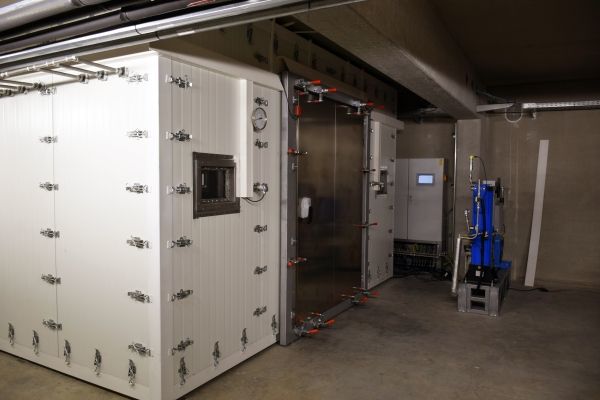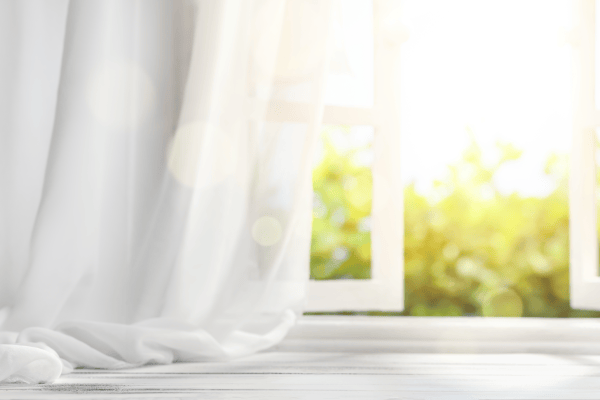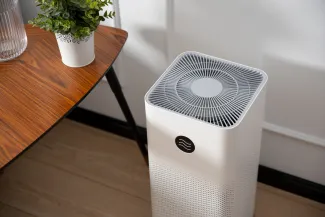
Luchtreinigers testen
Tijdens de COVID-19-periode zijn luchtzuiveringstoestellen populair geworden, met een groeiende vraag van zowel de overheid als de particuliere gebruikers naar kwalitatieve luchtreinigers. Er zijn meerdere normen om deze toestellen te testen, daarom is het belangrijk dat de juiste norm gekozen wordt. VITO ondersteunt je bij de keuze en voert de testen uit in een gespecialiseerde omgeving.
Laat je luchtreinigers vakkundig testen
Een luchtzuiveringstoestel kan zowel chemische stoffen, fijn stof en microbiologische pollutie in de lucht reduceren. Welke parameters uit de lucht juist gereduceerd worden is afhankelijk van het toestel. Een toestel dat niet goed ontworpen is kan schadelijke bijproducten vormen, daarom is het belangrijk om dit op te volgen.
VITO heeft meer dan 30 jaar ervaring in het testen van luchtzuiveringsinstallaties in de industrie en in binnenluchtkwaliteitsmetingen. Met de combinatie van deze expertises is een nieuwe testkamer van 30 m³ gebouwd om luchtreinigers uitgebreid te testen.
Onze meetaanpak voor luchtreinigers
Een luchtzuiveringstoestel kan in het labo onder ideale omstandigheden getest worden in een testkamer van 30m³ of in een tunnelopstelling. Hierbij wordt een continue toevoer van lucht met gekende concentraties aan polluenten voorzien en wordt per component bepaald wat de reductie-efficiëntie is en welke mogelijke bijproducten er gevormd worden.
Na een initiële test in het labo kan de werking van de luchtreiniger op locatie gemeten worden.
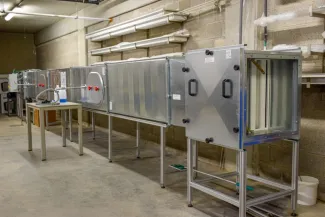
De tunnelopstelling waarmee luchtzuiveringstoestellen getest worden.
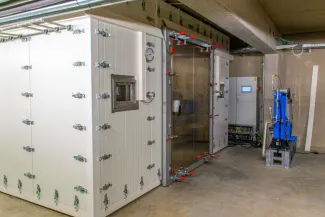
The 30 m³ test chamber
Meer weten?
Heb je graag meer informatie over het testen van luchtzuiveringstoestellen? Neem dan vrijblijvend contact op met Jeroen.
De toegepaste normen in het VITO-labo
- NBN EN 16846-1 – Photocatalysis — Measurement of efficiency of photocatalytic devices used for the elimination of VOC and odour in indoor air in active mode Part 1: Batch mode test method in closed chamber
- NF B44-200 – Independent air purification devices for tertiary sector and residential applications Test methods — Intrinsic performances
Andere mogelijke normen:
- ANSI/AHAM AC-1-2020 - Method for Measuring Performance of Portable Household Electric Room Air Cleaners
- ANSI/AHAM AC-4-2022 – Method of Assessing the Reduction Rate of Chemical Gases by a Room Air Cleaner
- AHAM AC-5-2022 – Method for Assessing the Reduction Rate of Key Bioaerosols by Portable Air Cleaners Using an Aerobiology Test Chamber
- ANSI/ASHRAE Standard 52.2-2017 – Method of Testing General Ventilation Air-Cleaning Devices for Removal Efficiency by Particle Size
- ANSI/ASHRAE Standard 62.1-2022 – Ventilation and Acceptable Indoor Air Quality
- ANSI/ASHRAE Standard 145.1-2015 – Laboratory Test Method for Assessing the Performance of Gas-Phase Air-Cleaning Systems: Loose Granular Media
- ANSI/ASHRAE Standard 145.2-2016 – Laboratory Test Method for assessing the Performance of Gas-Phase Air-Cleaning Systems: Air-Cleaning Devices
- ANSI/ASHRAE Standard 185.1-2020 – Method of Testing UV-C Lights for Use in Air-Handling Units or Air Ducts to Inactivate Airborne Microorganisms
- ANSI/ASHRAE Standard 185.2-2020 – Method of Testing Ultraviolet Lamps for Use in HVAC&R Units or Air Ducts to Inactivate Microorganisms on Irradiated Surfaces
- IEC 63086-1 – International standard – Household and similar electrical air cleaning appliances – Methods for measuring the performance. Part 1: General requirements
- ISO 16000-36:2018 – Indoor air - part 36: Standard method for assessing the reduction rate of culturable airborne bacteria by air purifiers using a test chamber




